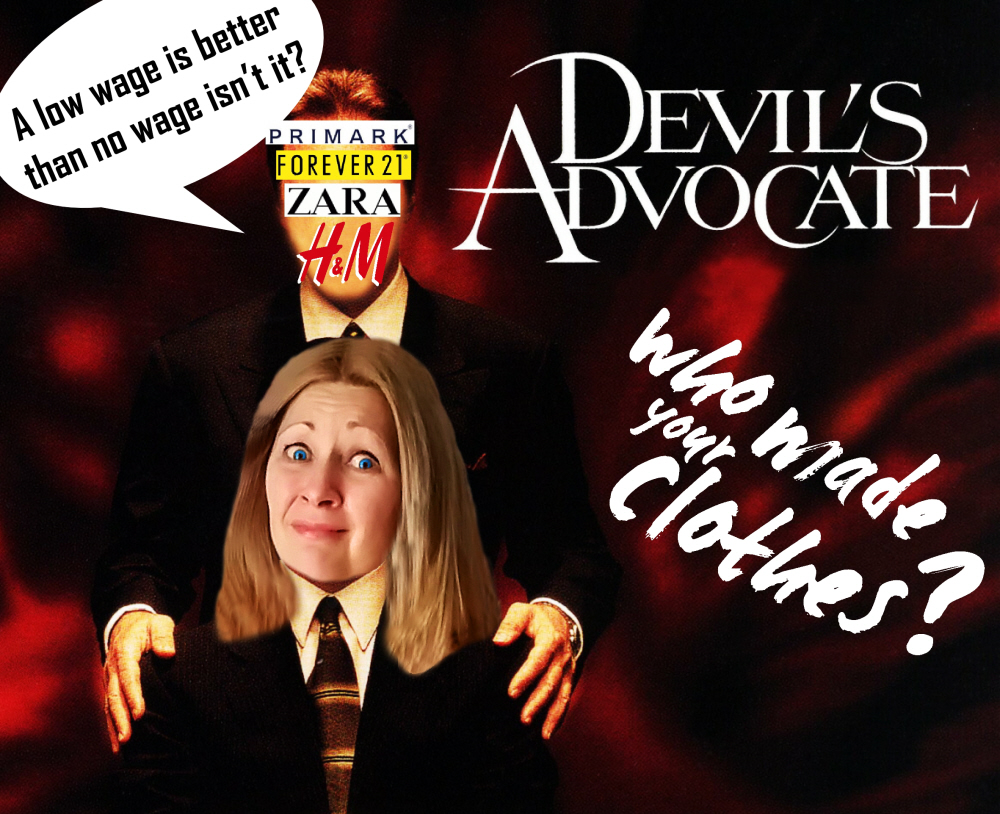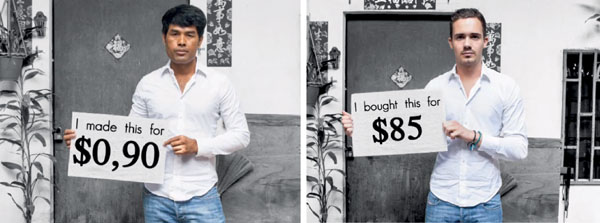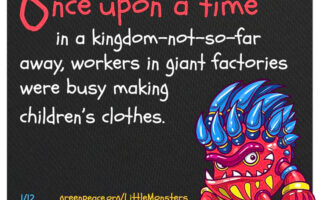I’ve been receiving a huge variety of comments, messages and e-mails on my (un)ethical fashion posts and as loads of the less than complimentary responses contain the same basic theme I thought it might be wise to tackle it head on.
And just what is the devil’s advocate of unethical fashion that so many feel compelled to write and share their opinions about?
The fight for a living wage for garment workers or more specifically:
“Isn’t a low wage better than no wage at all?”

I’ve awoken to find polite and (incredibly) rude variations of this question in my inbox too many times to count so let’s dive right in with my response:

This “playing devil’s advocate” reasoning by consumers is exactly what the billionaires behind unethical fast fashion brands rely on to be able to continue taking gross and immoral advantage of their garment workers.
Sure, a low wage might be better than no wage but why is a living wage so impossible to pay for these huge, wealthy international companies? And why is that cheap fast fashion garment more important to the average shopper than standing up and ensuring that the people who made it earn a salary that actually pays for the bare necessities of life and work in safe conditions?
Consumers who continue to buy unethically produced fashion are indeed not only condoning but also supporting the immoral labour practices of the brands.

A garment worker’s wage is only 1% to 3% of the total individual cost of most clothing items – this is a deplorable fact.
Stop and think about that for a moment and tell me how adding a mere 1% – 3% more to the cost of a garment could possibly be negative or even noticeable for the consumers or the brands? However that 1% – 3% more would make a massive difference to the quality of life of the garment workers.
If a brand sells a shirt for $10 the worker who made it received 24 cents at most. Doubling this wage would only be another 24 cents. Consumers would barely notice this type of increase, and if a consumer won’t notice it a massive wealthy company definitely won’t suffer profits from it. These types of costs could easily be absorbed into the profit margins of these billion dollar brands.

At the end of 2015 garment workers in Cambodia were being beaten, jailed and even murdered for protesting and demonstrating to be paid the barely living wage of $177 per month. Their efforts did indeed raise the minimum garment industry wage from $128 to $140 per month which is still well below the average living wage of $185.
Appallingly it is preferable to be employed as a prostitute than a garment worker in the Philippines. This harrowing documentary about the women making fast fashion in the Philippines by Vice News’ founder Suroosh Alvi is a must watch for anyone who buys fast fashion:
The 10 Biggest Excuses For Not Paying a Living Wage (And Why They Suck) by The Clean Clothes Campaign is an absolutely brilliant article which debunks the illogical reasons companies and consumers use for not providing a living wage and safe working conditions to garment workers. Numbers 5 & 6 (see below) are my faves:
5. WE’RE HELPING WORKERS WHO WOULD OTHERWISE BE UNEMPLOYED
It’s true that, for many workers, getting a job at a garment or sportswear factory is better than some of the alternatives—that’s why so many depend on them. The fact that people are desperate isn’t an excuse to exploit them. Workers aren’t getting their fair share of the benefits they are creating for the big companies.
We welcome the fact that millions of people are earning a wage. This alone, however, is not enough to lift them from poverty if employers can hire and fire at will, deny union rights, pay low wages that drive people to work inhumane hours just to survive, avoid paying sick leave, and avoid observing maternity rights.
For many workers, these jobs carry devastating hidden costs, such as poor health, exhaustion, and broken families, all of which are unacceptable and avoidable. Everyone wants and is entitled to a quality job that pays “just and favourable remuneration ensuring for himself and his [or her] family an existence worthy of human dignity,” per Article 23(3) of the Universal Declaration of Human Rights.
6. THE COST OF LIVING IS LOWER OVER THERE SO WE CAN PAY WORKERS LESS
Of course it’s true that the cost of living in many countries is much lower than in the United States and Europe—that’s why we don’t compare our wage levels with workers elsewhere. We do know from our partners around the world, however, that the minimum wage in each country is never enough to provide a “living” wage for workers and many garment workers don’t even get paid the minimum. A garment worker in Cambodia has to work two hours to afford one kilo of rice. The same worker in Norway can buy 14 kilos for just an hour of work.
A living wage enables workers to meet their needs for nutritious food and clean water, shelter, clothes, education, healthcare, and transport, as well as allowing for a discretionary income. It should be enough to provide for the basic needs of workers and their families, to allow them to participate fully in society and live with dignity. It should take into account the cost of living, social security benefits, and the relative standards of other groups. This is what we believe each worker should be able to earn within a normal working week and this currently isn’t the case.
Share your thoughts in the comments below.
Disclaimer: I am not at all an expert on the big business of fast fashion however I am a concerned consumer who has chosen to learn & share as much as I can through my own personal experiences & the wealth of resources available online.
Discover how to use what you have to create what you want at RefashionistaSheri.com







Hi you may already have talked about it but if so, I missed it. Is there a list of companies (and therefore stores) selling fashion that would not be “fast fashion” as in “we don’t care if people die making it”?
I really don’t like the “any wage is better than no wage at all” theory plus to be perfectly honest, I really don’t like the cheap fabric and cut that we find in fast fashion stores.
I am a “thrifter” but where do I get my clothes? In my sister and mother’s closets, in a thrift shop in my neighbourhood & what do I get? Mostly fast fashion stores clothes, maybe less cheap in the making, but anyway clothes that have been at one point made in the same kind of unethical conditions. I certainly get that if nobody buy those clothes, companies will have to make things better, but right now I don’t know how to make sure I am not contributing one way or the other to that economy. Thank you for those articles.
Thanks for your comment Kathy 🙂 Trying to shop ethical is definitely a challenge.
The Fair Wear Foundation has a list of brands that are regularly checked and meet their labour, wage and working conditions standards, get more info here: http://awesomesauceasshattery.com/2015/02/13/fair-wear-foundation/
The Clean Clothes Campaign is another organization that provides lots of info and searchable resources about the working conditions behind fashion companies: http://awesomesauceasshattery.com/2015/02/20/the-clean-clothes-campaign/
I share my thoughts about the ethics of thrifting and shopping second hand here: http://awesomesauceasshattery.com/2016/01/15/is-thrifting-really-ethical/
Brava! Well put, Sheri! 🙂
Thanks Heather, I simply can’t get my head around how the bulk of consumers can so easily disregard the basic human rights of the people who make their clothing 🙁
Excellent post Sheri!
Cheers Vee, the solution of raising the price of garments by 1% – 3% to provide an actual living wage is so bloody simple & logical and yet for some reason the multi-billion dollar brands can’t seem to pull their heads out of their asses long enough to actually make it happen.
I agree with you, especially on your first point regarding hourly wage as a percent of total cost. Further, I don’t think folks realize that by allowing these practices to continue, we are ultimately moving manufacturing out of the US. Fact is, not every American will attend college and become a lawyer. Soon all that will be left for persons without college degrees will be service positions. The union backed fair wage manufacturing positions will all be gone.
According to a 2013 study conducted by the American Apparel & Footwear Association more than 97 percent of apparel and 98 percent of shoes sold in the U.S. are made overseas and I’m inclined to believe that a similar statistic applies to most developed countries. Unfortunately wealthy companies will always manufacture their goods in the cheapest possible way, sadly this is usually at the cost and exploitation of the people actually doing the manufacturing.